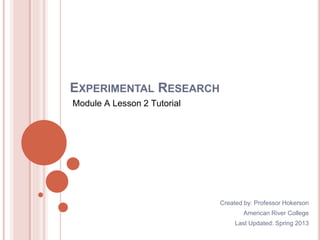
Experiments Tutorial
- 1. EXPERIMENTAL RESEARCH Module A Lesson 2 Tutorial Created by: Professor Hokerson American River College Last Updated: Spring 2013
- 2. USING THIS TUTORIAL Use the navigation buttons to advance through the slides. Complete each slide as instructed. Click on hyperlinks when prompted. Have fun and learn!
- 3. TABLE OF CONTENTS Objectives Module A Objectives #19 -20 Action Items A Comparison Experimental Research Design Independent Variable Dependent Variable Creating Groups Research Examples Identifying Research Examples Conclusions
- 4. MODULE A OBJECTIVES By the end of this tutorial you will be able to… # 19 – Explain what makes the experimental research distinct from correlational and descriptive designs. #20– Identify the dependent variable, independent variable, control group, and experimental group by reading examples of actual experimental research.
- 5. ACTION ITEMS
- 6. A COMPARISON OF RESEARCH DESIGNS Descriptive - “Strategies for observing and describing behavior” (Hockenbury, Nolan, & Hockenbury, 2015, p.21) Surveys Interviews Case Studies Naturalistic Observations Correlational – measures how closely variables relate to each other Each strategy has its own strengths and weaknesses! “Method used to demonstrate a cause-and-effect relationship between changes in one variable and the effect that is produced on another variable” (Hockenbury, Nolan, & Hockenbury, 2015, p.26) An experiment requires intentional manipulation. Experiments also have strengths and weaknesses! Descriptive & Correlational Experimental Method
- 7. EXPERIMENTAL RESEARCH DESIGN Read: Chapter 1 – The Experimental Method (pages 26 – 30) Tip! Researchers choose this method for one reason… To show cause – and – effect! Summary: Experiments must have all these components: Independent Variable Dependent Variable Experimental Group Control Group
- 8. THE INDEPENDENT VARIABLE A is the variable that will produce a change in B. Definition: variable that is intentionally manipulated by the researchers It is the focus of the study Tip! There must be an independent variable or it cannot be an experiment. Remember that this method attempts to describe a causal relationship between two (or more) variables. Conclusions: An experiment can produce two results: There is a causal relationship (A did change B) There is no causal relationship (A did not change B)
- 9. THE DEPENDENT VARIABLE A is the variable that will produce a change in B. Definition: variable that is measured in response to the independent variable Tip! An experiment cannot determine the effect of Variable A if its effects are not measured. Therefore, B (the dependent variable) measures those effects. Conclusions: Dependent variables look a lot like descriptive methods: Surveys and questionnaires Behaviors that are observed and recorded Computer generated activities and games
- 10. CREATING GROUPS Tip! To conclude cause-and-effect the researcher must expose some of the subjects to the independent variable The researcher also needs to have a group of subjects that are not exposed to the independent variable This is the manipulation! Caveat: The simplest design has 1 experimental group and 1 control group, but there are many studies in which there are more than 2 groups!
- 11. EXPLANATION OF EXPERIMENTAL DESIGN Subjects are randomly assigned into either the control or experimental group. The experimental group receives the IV… …the control group proceeds directly to the dependent variable OR receives a placebo first. Both groups complete the dependent variable. Tip! If you cannot find these 4 components then you are reading descriptive or correlational research and can never, ever, ever conclude cause! Subjects Experimental Group Independent Variable Control Group Dependent Variable
- 12. RESEARCH EXAMPLES Read: Here are some actual research examples: 1. A study reported that babies and infants that watch programs geared toward enhancing intelligence use fewer words than their non-program watching cohorts. 2. A longitudinal study reported that factors such as motivation, creativity, and willingness to work hard are predictors of academic success. 3. A study reported that antidepressant use by adolescents can increase the risk of suicide Caution: There are still many considerations to be made about these studies. Don’t draw any conclusions yet! Review: There are other research considerations to explore: Ethical Considerations – pages 34 - 35 Sampling issues – page 23 Replication and Validity – page 19
- 13. IDENTIFYING RESEARCH METHODS Question: How do you know if what you are reading is descriptive, correlational, or experimental research? Tip: Decision Making Tree 1. Do any of the conclusions say “cause”? 2. Are the subjects intentionally split into groups? 3. Do the subjects all do the same thing? Activity: Complete the Research Examples Worksheet to practice differentiating between descriptive and experimental research.
- 14. EXPERIMENTAL DESIGN CONCLUSIONS Only an experiment can conclude cause-and-effect. Researchers intentionally manipulate these studies. Any other type of research is either descriptive or correlational. Experiments are highly controlled. Subjects are randomly assigned into different groups. Experiments are often conducted in labs or other unnatural settings. You should always walk away from research with more questions than answers. How can the results apply in other settings? Who were the subjects? Can any other variables explain the results?
- 15. MODULE A OBJECTIVES After completing this tutorial you should be able to… # 19 – Explain what makes the experimental research distinct from correlational and descriptive designs. #20– Identify the dependent variable, independent variable, control group, and experimental group by reading examples of actual experimental research.